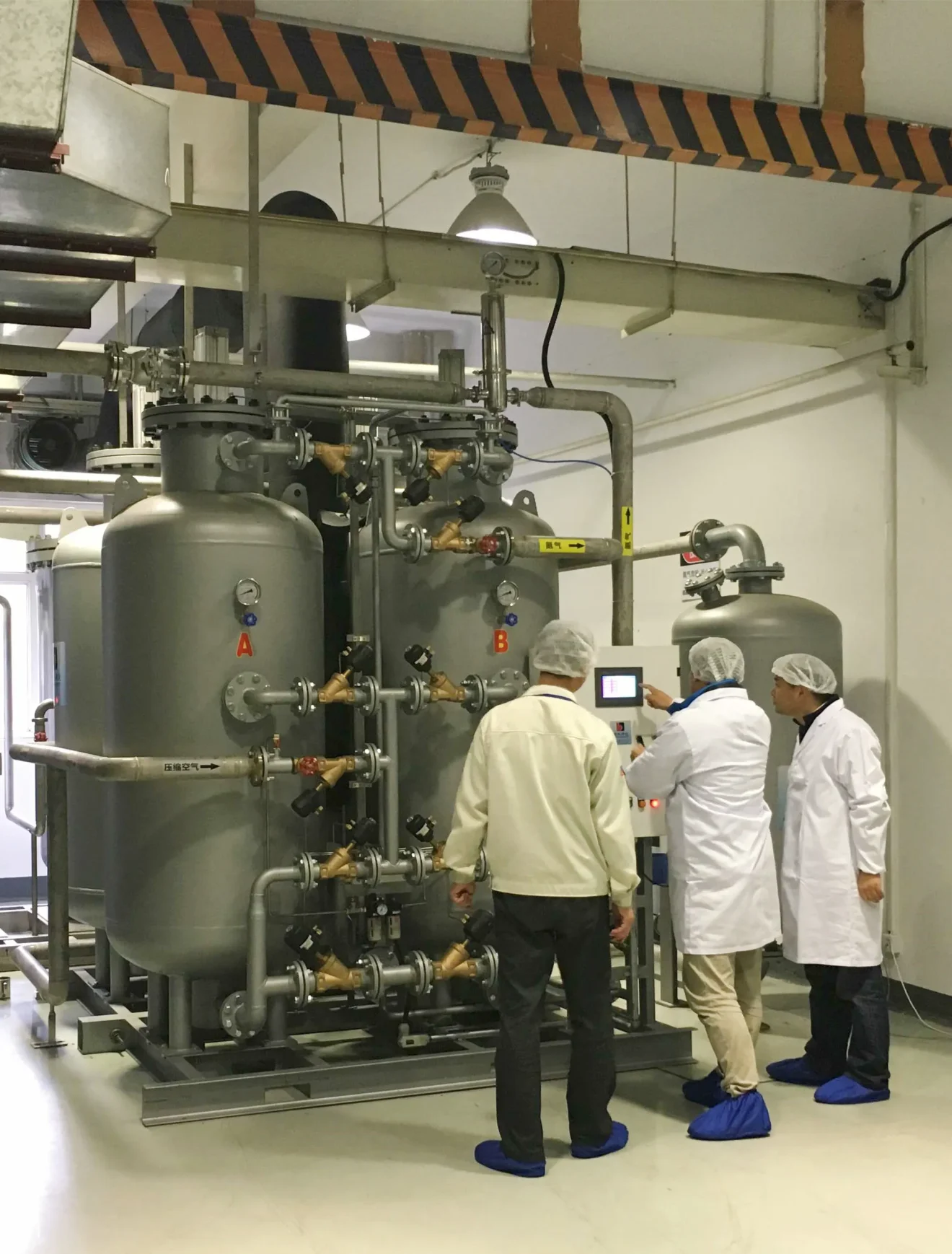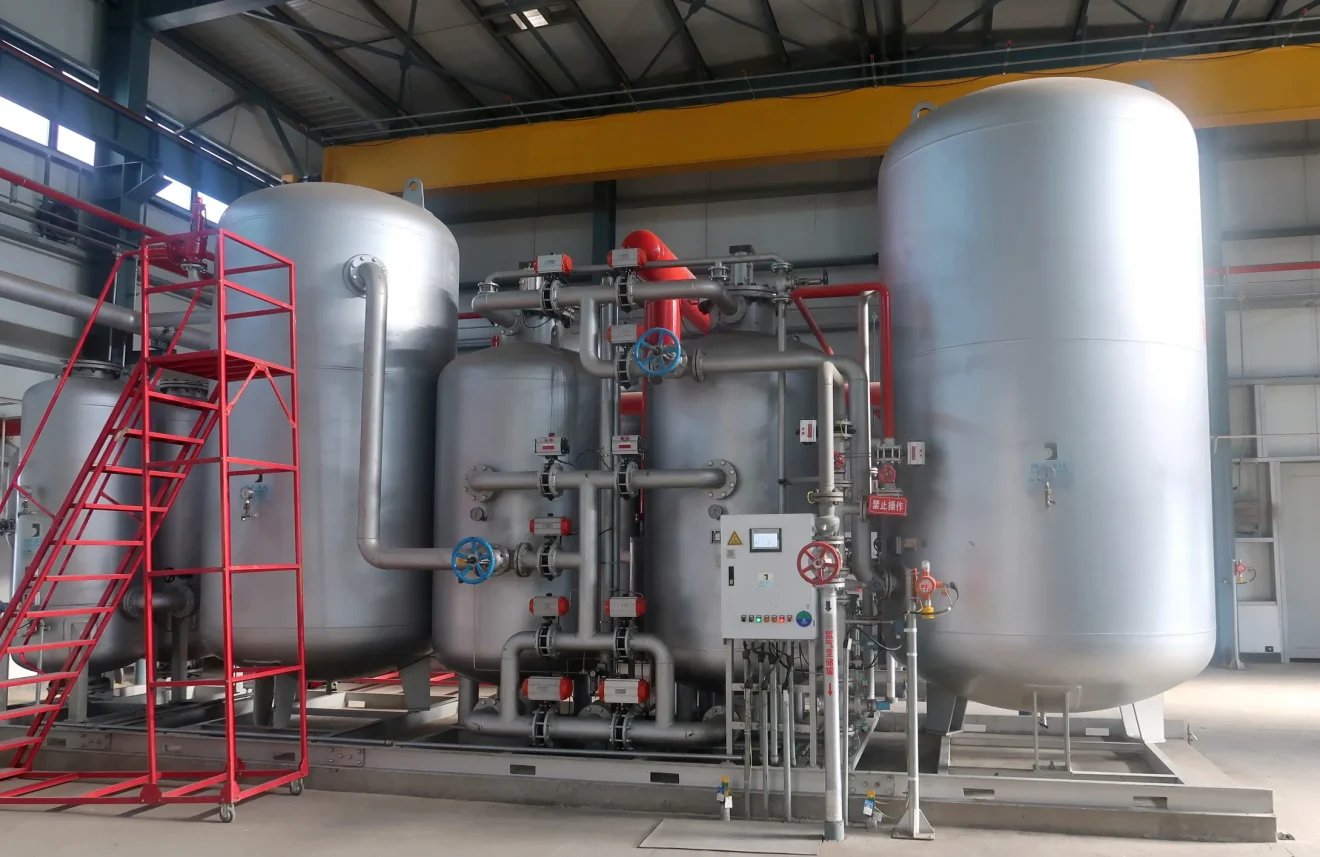When considering a nitrogen generator plant, it is important to understand the essential components that make up a complete system. Key components include the air compressor, multi-stage filters, compressed air dryers, oxygen-nitrogen separation unit, nitrogen storage tanks, and control cabinets. Each of these components plays a specific role in the generation of high-purity nitrogen gas. Let’s dive deeper into the necessary parts and their advantages, and explore how each contributes to the efficiency and reliability of the nitrogen generation process.
The primary process components of a nitrogen generator, typically using Pressure Swing Adsorption (PSA) technology, include: compressed air inlet, adsorption towers filled with carbon molecular sieve (CMS), pressure regulating valves, a control system to manage pressure swings, and an outlet for purified nitrogen; where the CMS selectively absorbs oxygen molecules from the air, allowing nitrogen to pass through as the purified product.
As we explore the components of a nitrogen generator, it’s important to understand how they all work together to ensure the efficient production of nitrogen gas. From the air compressor that supplies the necessary compressed air to the adsorption towers where nitrogen is separated, each component plays a pivotal role. In the following sections, we will break down the purpose and necessity of each individual part, offering insights into how the nitrogen generation system works and why these components are crucial for reliable performance.
How Does a Nitrogen Generation System Work?
A nitrogen generation system primarily functions based on the principles of Pressure Swing Adsorption (PSA) technology. The PSA process is designed to separate nitrogen from the air. The system begins with compressed air being filtered to remove impurities, after which it enters the adsorption towers, which are filled with the carbon molecular sieve (CMS). The CMS selectively absorbs oxygen, allowing nitrogen to pass through as the purified gas. The purified nitrogen then exits the system, ready for use, while the oxygen is removed and vented out.
The Air Compressor: The Air Source of the System
The air compressor is the first essential component in the nitrogen generation process. It serves as the source of compressed air that will undergo filtration and separation to produce nitrogen. The compressor works by taking in atmospheric air and compressing it to a higher pressure. The compressed air is then delivered into the filtration system, where it is processed before it reaches the adsorption towers. The air compressor’s role is vital, as without a sufficient and consistent air supply, the entire nitrogen generation system would fail to operate effectively. A well-maintained compressor ensures that there is a steady flow of air, contributing to the reliability and efficiency of the system.
The Necessity of a Wet Air Buffer Tank
The wet air buffer tank is an essential part of the nitrogen generation system because it helps regulate the pressure of the incoming air and temporarily stores it before it enters the filtration and adsorption stages. Wet air, which contains moisture, can cause damage to the internal components of the system, particularly the adsorbent material in the towers. By using a wet air buffer tank, the moisture content in the air can be managed more effectively, ensuring the longevity and optimal functioning of the entire nitrogen generation system. This component helps in maintaining stable pressure, contributing to more consistent performance and higher nitrogen purity.
Precision Filter: Ensuring Clean Air for Nitrogen Production
Precision filters are critical in ensuring the purity of the air entering the nitrogen generator. These filters remove particulate matter, dust, and other contaminants from the compressed air before it enters the adsorption towers. Without a precision filter, the particles in the air can clog the adsorbent material, such as the carbon molecular sieve (CMS), reducing the system’s efficiency and lifespan. The precision filter ensures that only clean, contaminant-free air reaches the PSA system, ultimately improving the quality of the nitrogen produced. This step is crucial to the overall process of nitrogen production as it enhances the purity and reliability of the generated nitrogen gas.


The Necessity of Activated Carbon Filter
An activated carbon filter plays a crucial role in removing volatile organic compounds (VOCs) and trace gases that might be present in the compressed air. These contaminants can have adverse effects on the purity of the nitrogen produced. The activated carbon filter works by adsorbing these unwanted substances, ensuring that only pure, clean air reaches the adsorption towers where nitrogen is separated. The necessity of this filter lies in its ability to improve the efficiency of the PSA process and the quality of the final nitrogen product. Activated carbon filters are essential for maintaining the integrity of the entire nitrogen generation system.
The Air Dryer: Removing Moisture to Maintain Nitrogen Quality
The compressed air dryer is another critical component in the nitrogen generation process. Its primary function is to remove excess moisture from the compressed air before it enters the adsorption towers. Moisture in the air can significantly affect the performance of the carbon molecular sieve (CMS) and reduce the efficiency of the nitrogen separation process. The air dryer uses cooling or adsorption techniques to lower the moisture content to acceptable levels, ensuring that the air entering the system is dry and ready for effective nitrogen production. This step is necessary for maintaining the overall quality and purity of the nitrogen gas produced, preventing moisture from compromising the system’s efficiency.
Compressed Air Tanks: Storing Air Before Nitrogen Production
Compressed air tanks serve as storage units for the compressed air before it is processed in the nitrogen generator system. These tanks help in stabilizing air pressure and acting as a buffer between the air compressor and the filtration system. By storing air at high pressure, the tanks ensure that a consistent supply of air is available for the nitrogen generation process. Without air storage tanks, fluctuations in pressure from the compressor could disrupt the smooth operation of the system, resulting in inconsistent nitrogen output. Compressed air tanks are essential for ensuring a steady and reliable supply of air, which directly influences the performance and efficiency of the nitrogen generator.
Nitrogen Generator: Producing High-Purity Nitrogen
The nitrogen generator is the heart of the nitrogen production process. It uses PSA technology to separate nitrogen from the incoming compressed air. The adsorption towers filled with carbon molecular sieve (CMS) adsorb oxygen from the air, leaving behind nitrogen, which is then purified and sent out of the system. The purity of the nitrogen depends on the quality of the CMS and the efficiency of the pressure swings. A high-quality nitrogen generator ensures that the final nitrogen product is of high purity, meeting the required specifications for various industrial applications. The generator plays a critical role in ensuring that nitrogen is produced in the most cost-effective and reliable way.
The Necessity of a Nitrogen Buffer Tank
The nitrogen buffer tank is crucial for stabilizing the flow of nitrogen produced by the system. As nitrogen is generated, it needs to be stored temporarily to allow for a steady and consistent supply. The nitrogen buffer tank ensures that there is always a reserve of nitrogen available for immediate use, preventing any interruptions in the supply. This tank also helps manage fluctuations in demand, ensuring that the nitrogen production system can meet varying needs. Without a nitrogen buffer tank, the system would experience unstable output, making it difficult to maintain a continuous and reliable nitrogen supply for industrial applications.
In conclusion, the components of a nitrogen generator plant work together to ensure the reliable and efficient production of high-purity nitrogen. From the air compressor to the nitrogen buffer tank, each part plays a crucial role in the overall process of nitrogen generation. Understanding the function and necessity of each component helps ensure that the system operates optimally and produces the highest quality nitrogen for various applications.




